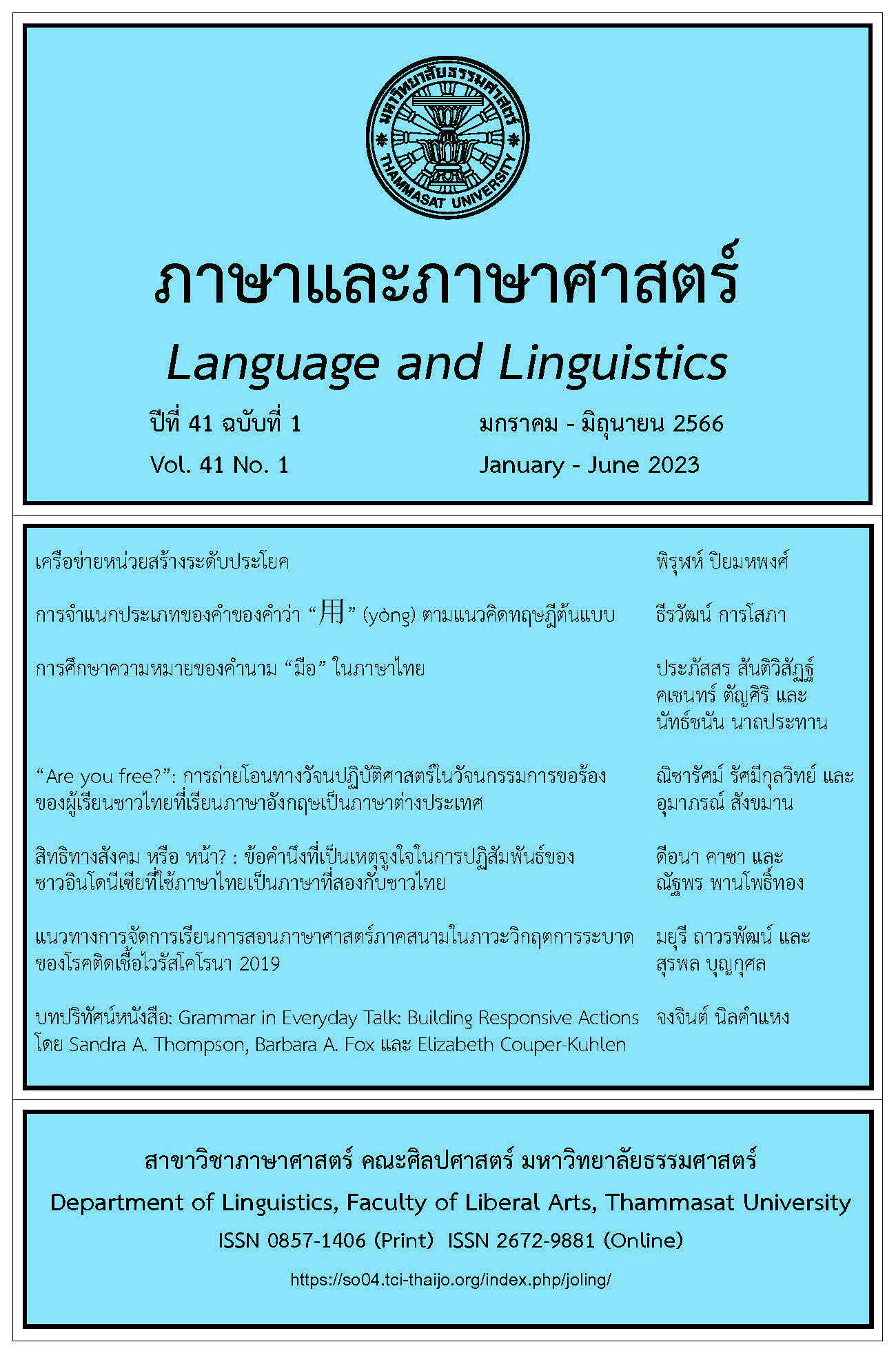A Study of the Meaning of “Hand” Nouns in Thai
Main Article Content
Abstract
The objective of this article is to analyze and categorize meanings conveyed by the noun, /mɯɯ/ ‘hand’ in Thai according to the Prismatic Model and Principled Polysemy. The study found that the meaning ‘part of the body’ is the basic meaning of the noun under investigation. It was also found that there are eight extended meanings which are: a) ‘to do something’, b) ‘ability to perform any task’, c) ‘possession’, d) ‘power’, e) ‘responsibility’, f) ‘person’, g) ‘assistance’, and h) ‘benefit’.
Article Details

This work is licensed under a Creative Commons Attribution-NonCommercial-NoDerivatives 4.0 International License.
บทความทุกบทความเป็นลิขสิทธิ์ของภาษาและภาษาศาสตร์
References
จรรยา ดุลยะลา. (2555). ความหมายเชิงเปรียบของคำเรียกอวัยวะร่างกายในถ้อยคำภาษาจีนและภาษาไทย [วิทยานิพนธ์ปริญญามหาบัณฑิต]. มหาวิทยาลัยมหาสารคาม.
จิดาภา ตั้งดิลกธนากุล. (2564). มโนทัศน์เวลาในภาษาไทย [วิทยานิพนธ์ปริญญามหาบัณฑิต]. มหาวิทยาลัยเกษตรศาสตร์.
ชลันดา รัตนธรรมสกุล และ นัทธ์ชนัน นาถประทาน. (2564). การศึกษาโครงสร้าง หน้าที่ และความหมายของคำบุพบท ‘หลัง’ ในภาษาไทย. ภาษาและภาษาศาสตร์, 39(2), 114-136.
เบญญาทิพย์ ศุภะกะลิน. (2561). อุปลักษณ์เชิงมโนทัศน์คำเกี่ยวกับคำเรียกอวัยวะในภาษาจีนและภาษาไทย. วารสารภาษา ศาสนา และวัฒนธรรม, 7(1), 184-211.
สำนักราชบัณฑิตยสถาน. (2524). พจนานุกรมศัพท์สังคมวิทยา ฉบับราชบัณฑิตยสถาน. รุ่งศิลป์การพิมพ์.
สำนักงานราชบัณฑิตยสภา. (2554). พจนานุกรมฉบับราชบัณฑิตสถาน พ.ศ. 2554. www.dictionary.apps.royin.go.th
อมรา ประสิทธิ์รัฐสินธุ์. (2553). ชนิดคำในภาษาไทย: การวิเคราะห์ทางวากยสัมพันธ์. โรงพิมพ์จุฬาลงกรณ์มหาวิทยาลัย.
อุทุมพร มีเจริญ. (2542). การศึกษาความหมายเปรียบของคำศัพท์อวัยวะร่างกายในภาษาไทย [วิทยานิพนธ์ปริญญามหาบัณฑิต]. มหาวิทยาลัยธรรมศาสตร์.
Evans, V. (2004). The structure of time: Language, meaning and temporal cognition. John Benjamins.
Evans, V., & Green, M. (2006). Cognitive Linguistics: An introduction. Edinburgh University Press.
Geeraerts, Dirk. (2002). The interaction of metaphor and metonymy in composite expressions. In R. Dirven & R. Pörings (Eds.), Metaphor and metonymy in comparison and contrast (pp. 435-465). De Gruyter Mouton.
Ravin, Y., & Leacock, C. (2000). Polysemy: Theoretical and computational approaches. Oxford University Press.
Tyler, A., & Evans, V. (2003). The semantics of English preposition: Spatial scences, embodied meaning and cognition. Cambridge University Press.
Wei, L. (2010). A cognitive approach to metaphor and polysemy related to the human body school of teacher education. Kristianstad University.
Wongthai, N. (2015). The meaning extensions of human body part terms in Thai idioms. Asian Social Science, 11(9), 146-157.
Zhang, W. (2016). Variation in metonymy: Cross-linguistic, historical and lectal perspective. De Gruyter Mouton.


